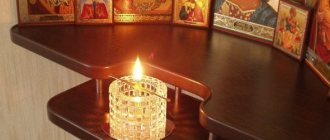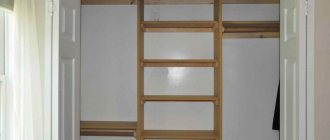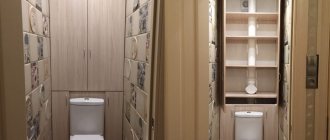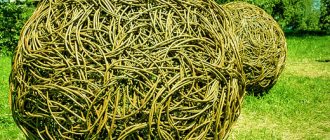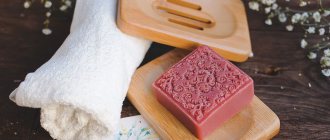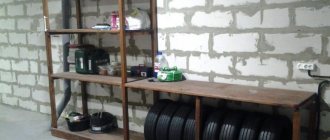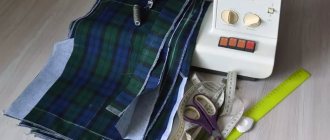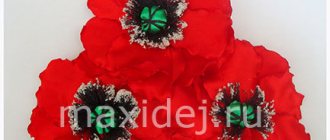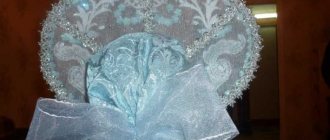Hi all! The question of faith is individual. It cannot be forced on anyone. But prohibiting faith is also wrong. One of the attributes of faith are divine icons. Since many people pray at home, a do-it-yourself corner shelf for icons will be an excellent solution.
Your own icon cabinet will fully meet your requirements, as well as satisfy requests for appearance, capacity and other parameters.
Yes, it will not be possible to assemble an iconostasis into a house or apartment. But making a shelf is quite possible. I propose to talk about how to make a shrine, and what is required for this.
You can take ideas from the photo. Or collect something of your own, unique, and also original. And then your idea will be copied and repeated in practice.
Making a shelf
If you do not have the opportunity to purchase a stand for images, or all the models that you have come across did not appeal to you or are not suitable (for example, a small number of tiers, limited space, etc.), then do-it-yourself homemade iconostasis, photos of which are presented in the article , you can make it yourself. For a standard three-tier iconostasis you will need wooden boards, a drill and screws. In order to assemble it, you need to create drawings of a home iconostasis. Using them, you can easily calculate the dimensions of the wooden panels, which will depend on the number of icons located on the iconostasis.
Making elements of the future shelf
The future do-it-yourself corner shelf for icons consists of several elements. Namely from:
- side panels;
- shelves;
- racks;
- sides.
Determine the dimensions based on what shape you have, as well as where the structure will be located.
It can be straight or angular. Today we are interested in the second option. Although straight shelves are easier to make. As is the case with wall flower shelves.
Stand for holy images made of plywood
Shelf parameters and design may vary. It is important that the icons you need are placed there. This plywood shelf will be made with dimensions of 30x35x4 cm. What you will need for this:
- Pine board measuring 1.5-2.0 cm thick and 15 cm wide.
- Prepared glued board to form the bottom of the cabinet, 1.5 cm thick and 21 cm wide.
- Small pieces of fiberboard and birch plywood for sketching.
- Sandpaper.
- Self-tapping screws.
- A jigsaw is best if it is electric.
- Drill and drill bits.
- Milling table.
- Lathe.
- Pencil and meter ruler.
First, we draw and prepare future templates from fiberboard. This is done simply:
- We make a drawing on the fiberboard in natural volume and cut them out using a jigsaw.
- Next, we sand it with sandpaper to the parameters we need.
- We delimit the places for screws on the templates.
- We take the prepared blanks, transfer them to plywood and cut them out using a jigsaw and grind off the irregularities.
- The result should be: side, side and bottom.
- Now mark the holes with a pencil. There should be 2 of them on the bottom, 3 on the side, 4 on the side. We drill out the marked places and get holes for connecting the template to the workpiece.
The last step is to attach the template to the workpiece using self-tapping screws.
The sides and sides are cut down in the same way, and 6 holes are marked: 2 on the bottom, 2 for the side, 2 for the side.
Now using the machine we make 2 identical parts.
History of the red corner
Every person has heard the phrase “red corner” or “God’s place”. However, not everyone knows why this place received such a name and how correctly it was located. You can often hear the answer that this is the right corner from the door. But it is not always the case.
Ethnographers claim that in past times, “God’s place” was located diagonally from the stove.
And this was done for a reason. The word red was associated with spring, summer and warmth, so they tried to place icons more on the south or east side.
The north and west for the ancient Slavs were comparable to death, evil spirits and severe winter. A little later, these stereotypes diverged, and people began to simply create cozy corners with numerous icons.
Design options
Orthodox canons suggest placing icons on the eastern wall. As an option, the place of the iconostasis is arranged in a corner directed to the east. Depending on the selected area, the shelf can be straight or angular. The small size of the corner shelf requires a multi-tier structure. The shelf can be equipped with a rear wall. Often it is decorated with carvings depicting birds, vegetation or the outlines of the holy apostles. The traditions of Orthodoxy do not provide for the placement of items not related to religion next to church paraphernalia. Having decided on the shape of the shelf, we move on to preparing the material and tools.
Sketch and detailed study
Once we have decided on the desired appearance of the future shelf, we start with a sketch. The outlines of the details are drawn on full-size paper. If everything suits you, we transfer the finished sketch to the material.
When making a shelf with shaped elements, there must be a straight section of 40 to 100 mm from the main side to the beginning of the bend between the main side and the beginning of the bend (see figure). With this approach, the edge becomes more precise after gluing.
DIY home iconostasis drawings photo
Home iconostasis made of natural wood with carved patterns The tradition of arranging a home iconostasis has existed for more than one century. Although in modern homes icons are often placed on bookcase shelves or hung on the wall, it is best to set up a separate special place for them.
Single-tier straight rack - shelf for icons
A good option would be a hanging shelf, which according to the canon should be placed on the eastern wall of the house. Often such a shelf is made corner, two or three tiers high.
Beautiful wooden shelf for icons in the corner of the room in three tiers
Corner shelf for icons with candlestick
Varieties
Shelf for icons “Home mini-iconostasis corner”
In workshops you can order a stand for home icons of any size and configuration, but this is quite an expensive job.
Corner shelf made of fiberboard, made in three tiers
An easier option is to use a regular corner shelf from a hardware store, but this may cause sizing issues. In addition, you will have to look for a model that will “fit” better into the interior. All these difficulties can be avoided if you make a shelf for icons yourself - this is quite feasible even with little experience in carpentry.
Wall-mounted corner shelf for wooden icons
A do-it-yourself icon shelf can have any convenient design. Corner shelves are made single-level or in several tiers. To connect several levels, supports carved from wood are usually used. The finished shelf is often decorated with carvings, openwork overlays, and covered with special carpentry varnish and wax.
Small corner shelf for icons, two tiers
DIY home iconostasis
Homemade shelf for icons
By putting love, soul, and heart into the process of creating an iconostasis, you can create not only something useful to use, but also a real design masterpiece. There are many options for making such shelves. But there are certain requirements for them.
Using modern materials and wood, you can make a corner shelf to suit every taste.
Thus, the frames of the images should not overlap. No foreign objects can lie next to them, only things that directly belong to the shrine.
What to make a shelf for a TV from
Imagination can spread in the choice of material for a television stand.
Of course, you can also make a shelf from Czech crystal, marble, mahogany, decorated with precious stones, ...........................................................................................................................................
But, remaining true to the principles of minimalism and ergonomics, we rely on common and cost-effective materials, such as
- wood, chipboard or MDF;
- Drywall;
- Plastic or organic glass;
- durable tempered glass;
Where and how to make a home iconostasis
According to church traditions, the iconostasis is placed on the east side, so first in an apartment or house you need to find a corner exactly looking east. If it is not possible to use the desired angle, then you need to find one close to it.
Since not everyone manages to adhere to these conditions, they were made optional. Usually the iconostasis is placed in a large spacious room so that at least 2 people can fit there. You cannot have a TV or computer nearby.
Create your own red corner
What the home iconostasis will be like depends only on the owners of the house. However, remember to follow the following rules:
- Holy images must be installed far from technology (TV, computer, etc.) - the farther from everything worldly, the better.
- There should be enough space in front of the icons so that those praying do not feel crowded. And during prayer, it is better to place church books (prayer books, the Gospel) on a folding lectern (stand).
- You should not place icons individually on bookshelves, in cabinets, while crowding these images with other worldly objects: souvenirs, pictures, etc. This is strictly prohibited, since by doing so we show disrespect for God. After all, for some reason, many people put photographs of people we love and care about, especially those who have left this world, in the most prominent place, without cluttering them with unnecessary objects. The same should be done with icons, showing love and respect for holy images.
Holy images for the goddess
There must be two holy images in the home iconostasis.
An image of the Son of God, testifying to the incarnation of God and the salvation of the human race. For prayer, a waist cloth is often chosen, on which the Almighty blesses the world with his right hand, and holds the Divine Scripture in his left hand. The Lord appears in these images as the Arbiter of every destiny, a merciful Father who gives the Truth to which the eyes of Orthodox followers are directed. In this regard, icons of the Son of God always occupy the main place on the shelves of the home iconostasis.
The face of the Mother of God, who is a perfect man and revered above the Seraphim and Cherubim. More often, images called “Tenderness” or “Hodegetria” are used.
- The author of the first type, whose lists are extremely common in the Orthodox world, is traditionally considered to be the Apostle Luke. In “Tenderness” there is a magnificent contact between Christ in infancy and the Mother of God, which symbolizes the union of the earthly and the heavenly, the Creator and the best of His creations. The image expresses the Creator’s infinite love for the human race, when God gave the Son to atone for sinfulness. The most common and famous icons of the “Tenderness” type include: Vladimir, “It is Worthy to Eat,” “Recovery of the Dead,” etc.
- “Hodegetria” (“Guide”) is the second common type of face of the Virgin Mary. The image demonstrates the true path to God. On the icon this is evidenced by the specific gesture of the right hand of the Mother of God, pointing to the Infant Christ. The most famous faces of “Hodegetria” are: Blachernae, Iveron, Tikhvin, Kazan, etc.
Read about the Mother of God icons for the iconostasis:
In the Orthodox tradition, the image of St. Nicholas the Ugodnik is extremely popular. It has always occupied an important place on the shelves of every Christian's iconostasis.
St. Nicholas is revered as an eternal servant of God, endowed with special grace.
An Orthodox Christian can place in the shrine the images of the famous prophet Elijah, the Great Martyr George the Victorious, Panteleimon, and the holy evangelist John the Baptist.
Advice! The choice is always individual, and the best assistant in the matter is the priest. They turn to him or another monk for advice.
Iconostasis in the house
Manufacturing stages
Carved corner shelf for handmade icons with a drawing Before starting work, you should make a drawing of the project. The size and number of shelves depend on the type of icons that will be placed on the finished home iconostasis. To make a simple two-tier shelf, you will need two 1.5 cm thick pine boards, as well as four supports.
We cut out three parts using a jigsaw according to the template - sidewall, side and bottom
The workpiece is milled using a stencil using special equipment
To turn decorative parts you will need a lathe or take them ready-made
We assemble the shelf - the bottoms are screwed to the turned elements using self-tapping screws
When connecting the sidewalls to the bottoms, the screws should hit the middle of the ends of the bottoms
The sides are screwed on using cylinders - self-tapping screws are inserted into the holes from the bottom, the cylinders are put on, the hardware is screwed into the side
The final stage is coating the finished product with drying oil and attaching it to brackets in the corner
After completion of the work, the finished shelf is treated with stain and varnish. Both colorless varnishes and those that give the board the color of different types of wood are suitable. When choosing a quick-drying varnish, the product is ready for use in a few hours.
Small shelves for icons of different colors - pine, walnut, mahogany
Decoration methods
Self-made shelves for icons need finishing and decoration. This will give them a fresh and solemn look that matches the purpose of the products.
There are the following decorative options for stands for images:
- waxing;
- stain impregnation;
- varnish coating;
- adding overhead openwork details;
- artistic carving;
- engraving or burning;
- wood painting;
- applying stencils and airbrushing;
- glitter, beads and beads.
It is allowed to combine several finishing methods in one product. The main thing is that it does not look too colorful, overshadowing the image.
Wood carving
Each shelf should have a crucifix. It is made in a volumetric version by carving solid wood. In most cases, such work is entrusted to craftsmen and it is expensive. You can make an Orthodox cross yourself, using a set of well-sharpened cutters. In addition to the crucifix, relief images of domes, images of saints and martyrs, fish, birds, animals and fairy-tale characters are applied to the walls and sides. It is allowed to cut out patterns and bas-reliefs.
Execution of volumetric fragments is carried out in the following sequence:
- Selecting or making an image, transferring its outlines and small details to the workpiece.
- Sawing the part along the contour, grinding off sharp edges, removing sawdust.
- Making convex parts with cutters. This should be done in stages, with thin petals.
- Process the product with fine sandpaper. If necessary, coat it with a primer or other protective liquid.
The crucifix and overlays are glued to the back wall. To do this accurately and without distortions, you should make outlines with a pencil.
Read on our website
DIY wall shelves Making a wall shelf with your own hands is an interesting and creative activity. Everyone can be attracted to it...
Simulation process
Natural wood and good quality metal are not always at hand. Often craftsmen have to improvise to give image shelves an attractive look.
The following methods are used for this:
- Covering wood boards or plywood with adhesive film to match the color of valuable wood species, natural stone or metal. Individual pieces of film can be used to depict nature and church buildings.
- Artificial aging of wood and metal. The wood is given the appearance of an antique product by treating it with stain and steel brush. Copper and brass are soaked in salt water to create a patina.
- Adding gilding to the paint, which makes the carved domes look authentic.
The difference between icons and paintings
It is important to note that if there are some picturesque paintings in the house that depict various biblical scenes, they should under no circumstances be installed near the home iconostasis. Since it is known that with the help of holy images and icons, Orthodox believers communicate with all the saints and the Almighty, but there is no connection between the icon and the picture.
In this case, it is important to know that the home iconostasis is a holy place, a kind of small temple in your apartment and it is intended to offer prayers and thank the Almighty for help. Therefore, installing reproductions of various paintings depicting biblical scenes is inappropriate.
In your own apartment, you cannot place the Sacred Face close to posters or paintings depicting certain famous people. Because, in this way, Orthodox Christian believers insult the shrine, placing them, in some way, on a par between worldly idols and the Almighty.
It is known that the eastern part of an apartment or house is of particular importance for the Orthodox religion, therefore it is necessary to place home iconostases or create a red corner on the eastern side.
The eastern part has a definite place in all historical religious information, which is why the Old Testament speaks of the creation of paradise in the eastern part of Eden. The Gospel Scriptures say that lightning came from the east, and the Almighty also comes from heaven to earth from there. Every Orthodox parishioner knows that in a church the church altar is located on the east side.
Modern location of the iconostasis
For a family, this relic is a unifying prayer factor that arises after the forgiveness of all everyday grievances and the achievement of mutual understanding.
- Today's realities of life insist that the church allows you to set up a home iconostasis in a free place. However, orthodox rules recommend placing it on the eastern side. The concept of “east” has an important feature for Orthodoxy. It is written about him in the Book of Genesis, in Bartholomew and Matthew.
- If doors are located in the east of the apartment, it is allowed to use other cardinal directions.
- When choosing a place for a family altar, you need to avoid the proximity of holy images with any household appliances, which are considered a vain product of modernization and do not contribute to spirituality. It is necessary to avoid close proximity of icons and decorative decorations, as well as with books of a non-religious nature.
- For an Orthodox family, the presence of images of the Savior Christ and the Virgin Mary in the home iconostasis is mandatory. The image of the Messiah should always remain central, and all others will be smaller in size. The main icons (Trinity, Christ and the Virgin Mary) are located above the rest, but the Crucifixion is allowed to be placed above them.
How to correctly arrange icons in an apartment
- Decoration for the family iconostasis - fresh flowers. Large icons installed nearby should be framed with towels according to the ancient Christian tradition. It is prohibited to place non-canonical paintings or their reproductions nearby.
- The home iconostasis should be crowned with a cross, and a lamp should be lit during prayerful praise. On holidays, according to the church calendar, candle flames can burn for a whole day.
Important: enough space should be left in front of the iconostasis so that believers do not feel crowded during a family prayer service.
Icons for home iconostasis
The Orthodox Church attaches great importance to a “beautiful corner.” She says that a person has the right to pray not only in the temple, but to honor the Lord at home. A properly constructed chapel should contain the following images:
Some lay believers place the face of the Guide in the “red corner”. The Vladimir and Kazan images of the Mother of God are also allowed. At the same time, you need to turn to shrines not only for help. We should not forget to express gratitude for their support.
Special placement instructions
At home, you are allowed to follow only the basic rules of placement.
- It is necessary to maintain symmetry and systematicity, to think through the compositional structure, which will help avoid feelings of internal dissatisfaction and the desire to change something. Incorrect arrangement distracts from the prayer service, the essence of which is concentration on petition and praise.
- An Orthodox person is obliged to remember the principle of church hierarchy: locally revered icons cannot be placed above the main ones (Christ the Savior, the Virgin Mary and the Holy Trinity).
- The image of the Messiah must be placed on the right side of the upcoming believer, and the canvas with the face of the Virgin Mary on the left. When selecting an iconostasis, one should focus on the uniformity of artistic execution of the shrines. The Church is not recommended to allow diversity in styles.
- Orthodox people must take holiness very seriously, since it is one of the properties of God himself. This quality is reflected in heavenly saints and material objects. It follows: the veneration of holy governors and iconographies belongs to the same religious order.
- The degree of churching of a family is judged by the reverence that members show to the faces of Christ and the Mother of God. Ancestral icons have always been greatly revered. The newly baptized baby was brought to the shrine, and the priest read prayers praising God. In ancient times, through the icon, parents blessed their children for successful studies, travel to distant lands, and service to society. Before a wedding or after the death of a person, believers also turned to the saints for help.
- If an iconostasis is placed in the house, quarrels, disgusting behavior, and scandals on various topics are unacceptable. However, an overly reverent attitude towards shrines should not be transformed into idolatry. We must remember: icons are a divine image, but not the very personality of the Lord or His vicegerents.
- A canvas that has fallen into complete disrepair and cannot be restored cannot be thrown away; it must be treated with due respect and respect as an ancient tablet. Previously, if the colors on an icon were washed off, it was sent down the river. Today, such a rarity is taken to the church, where it is burned in the temple oven.
- If damage to the face occurred due to careless storage, one should confess, since the Church considers such irresponsibility a sin.
Important! The Savior, the Mother of God, the apostles and saints looking from the canvases belong to eternity. When asking them for intercession through prayer, we - residents of areas of sorrow - need to always remember the Almighty Creator, the call to voluntary repentance, self-improvement and mercy. Through the eyes of saints, the Almighty looks at people and reminds us that we have the opportunity to save our souls.
How to arrange a home iconostasis
Publication date: August 23, 2016
The temple is a house of prayer and a place for performing the sacraments. A home is a family hearth, but in the home of a believer there should be prayer, because the home of an Orthodox Christian is a small Church. And we pray in front of icons, and there must be icons in the house. In sufficient quantity, but within reasonable limits.
An Orthodox Christian living in a modern home often has questions: what icons should be in the house and how to place them correctly?
Installation of an iconostasis in the house
The arrangement of icons in a home iconostasis can be arbitrary, but in the Christian tradition there are some rules.
In past times, every family had a shelf where holy images were displayed. These divine paintings were located in the brightest and most eye-catching place. The shelf for icons was installed in the far corner of the house, in the East. This place was the most illuminated, since the two walls forming it had windows, where a lot of sunlight passed through.
Home iconostasis
An icon is a sacred image, which is separated from everyday realities and never mixes with everyday life, but is intended exclusively for dialogue with the Lord. It is a window from the infinite world, as well as divine revelations in the tones and lines of the icon painter’s brush.
It is naive to assume that a large number of holy images makes the life of an Orthodox believer more pious than it actually is.
About icons:
An unsystematized collection of icons, various reproductions, and church calendars is similar to ordinary collecting, where prayer completely disappears as an end in itself. Here there is a complete distortion of the term “house”, which is a continuation of the monastery.
Required materials and tools
To make a corner shelf, wood of various decorative species is used - for example, oak or cherry. A less expensive material would be pine board. In addition to wood, you can also use plywood or chipboard. The thickness of the board can vary from 1.5cm to 2.5cm. You will also need boards of small width in order to carve the supports.
To work you will need the following tools:
- tape measure or ruler;
- hacksaw;
- sandpaper for wood;
- electric jigsaw;
- electric drill;
- self-tapping screws;
- wood glue;
- wood varnish.
Required Tools
To attach the finished shelf to the wall, you will also need masonry drills, metal corners or hinges, and self-tapping screws with dowels.
Creating shelves for icons
For work related to the creation of shelves for icons, you need special tools for woodworking: drill, lathe, milling cutter, jigsaw.
The materials needed to make shelves for icons include boards from any wood, pieces of slabs, wax or varnish, silver and black paints, and wood glue. Component materials and hardware require carved slats, a metal or wooden crucifix. Screws and original plugs are suitable as fastening elements. To secure the product to the wall, you need hinges and dowels.
Some of the carved elements can be made with your own hands. For example, start making carved elements and original shelf parts. The crucifix, which is the center of the icon, is made only in carved form.
In addition to such details, the corner shelf for icons should have a back wall in the form of a carved iconostasis. The carving is made with floral ornaments, outlines of saints, and fabulous birds.
To decorate the upper part of the shelf for icons, you can choose the outline of an Orthodox church.
You can cut out bas-reliefs yourself and choose interesting reliefs. To carve a crucifix, you must first select a high-quality sketch, and only after that begin to implement your plans.
The types of wood from which a crucifix can be carved include birch, aspen, spruce, pine, and juniper boards.
What else was placed on the shelf for images?
It is worth recalling that iconostases in Ancient Russia contained not only holy water , various icons, but also prosphora. Also, residents of certain houses hid the Bible, Gospels and memorials in the red corner . The memorials were a kind of book in which the names of all family members were recorded, as well as all those who were living and those who had already died. Women of Ancient Rus' created some kind of doves from scrap materials as symbols of the Holy Spirit in order to later hang them near the home iconostasis. During the home service, lighted candles and lamps were placed in the red corner, which was an integral attribute during the Ascension of prayers.
Historians from around the world claim that home iconostases existed in every Orthodox home before the 1917 revolution. After the Bolsheviks came to power, Orthodox believers continued to pray, but they did this in secret from the government. Therefore, after a while, only a few icons remained from the huge, decorated home red corners, which believers hid from other people, fearing various persecutions, repressions and other gossip. If you turn to a modern Orthodox believer, you can find many different differences between the modern iconostasis and the red corner of antiquity. Since until now, historians have not established exactly what the iconostasis looked like, and what, in addition to holy images, books and lamps, was located in it.
How to make a home iconostasis with your own hands
Before making a home iconostasis in an apartment or house, it is recommended to first study the recommendations for its construction, then select the desired corner in the house. And only then consider all possible options for making an iconostasis with your own hands.
Of course, it cannot be mentioned that modern furniture stores, taking into account the needs of customers, also offer, albeit a small, but quite good selection of such corners. But most families want to make it individual and unique. By the way, special wall cabinets for icons do not have to be corner. It all depends on the location you choose.
The best article for you, go to: Easter is the holiday of the Holy Resurrection of Christ
There is also the option of making a special custom cabinet. In this case, all features and wishes will be taken into account. In this version, it can be folded from several colors or have a carving.
- To independently make a special corner for icons, you can use absolutely any materials.
- The main thing is to first make drawings of the cabinet that you want to place in your home for this purpose.
- And don’t forget about sufficient distance between the shelves. Since when candles are burning, they can heat up and ignite.
- As for the height of placement, there is no special technology or recommendations. Just remember that the horses should be at eye level, not higher or lower.
- If you have made shelves for icons, then it would be reasonable to place a table under it. It will be possible to light both candles and lamps on it.
- You can also place holy scriptures, holy water, etc. on it.
Master Class
Currently, the tradition of decorating your home with Christian icons is returning; even in city apartments you can find a homemade “red corner”, which is often called a shrine. If you choose the right materials for the shelf, it can be made into a functional decorative element of the apartment’s interior. The priests say that icon shelves should be in the home of every believer.
In the manufacture of such products, you can use wood, plywood, polymer materials, and metal.
Depending on personal preferences, shelves for icons can be single-tiered or multi-tiered structures. Icons for the iconostasis can be mounted on a table or placed on a shelf.
To create a three-tier structure, stock up on a hand-held milling machine, a jigsaw, a ruler, a pencil, nails or screws, abrasive material, a hammer, and wood glue.
In order for the shelf to be beautiful and delight its owner for a long period, it is important to carry out preliminary measurements of the width, height, and depth of the planned structure.
To ensure that there are no rolling pins or irregularities on the surface of the shelf, the surface is sanded with sandpaper.
To connect the parts together, you can use nails or screws. For strength, you can also arm yourself with glue designed for wood. You can varnish or stain wood to protect it from high humidity and temperature changes, and also to give the product an aesthetic appearance.
Basically, shelves for icons are arranged in three rows, but there is one main row - deisis. In order for the created iconostasis to be made correctly and reliably protect the apartment and its inhabitants, it is important to arrange the icons in a clear sequence.
The upper part is the deisis, in its center there should be an icon of Jesus.
To the left of her is the image of the protectress - the Most Holy Theotokos, and to the right side is always the icon of John the Baptist.
Ideally, the number of icons is 12 pieces - according to the number of major Christian holidays. On the bottom shelf of the iconostasis you create yourself, you can place any icons that are revered in a certain region.
What icons are needed?
Worshipers claim
that every Christian should have a home iconostasis or Red Corner in his home. It should contain the following images:
- icon of Jesus Christ;
Holy Face of the Mother of God;
image of St. Nicholas the Wonderworker;
the icon of the Almighty, which is considered most suitable for the Ascension of various prayers at home. It is worth noting that in this case, the temple ministers recommend that parishioners purchase a waist-length image of the Almighty.
Often, Orthodox believers choose to create an iconostasis in their own home, the Holy image of the Mother of God, which is called Tenderness or Guide. Some parishioners in the Orthodox Church choose the Vladimir icon of the Mother of God. There is no doubt that one of the Kazan icons, that is, the Help of Sinners or the Quick to Hear, should exist in the home iconostasis. Having installed holy images in the house, a person can not only ask them for help, but also thank them with their help.
Types of fastenings
The basis for a shelf of any design is the fastening.
This places special demands on load-bearing capacity and functionality. The most common types of fastenings are the following:
- Using angles. The simplest and most practical method chosen by most beginning craftsmen. But in order to implement such a mechanism for rotating shelves, it is necessary to experiment with fasteners.
- Loop fastening. Hanging shelves fit perfectly into the interior, do not require a special approach when choosing tools, but do not always meet the criteria for the stability of the entire structure.
- Using parentheses. Brackets are very practical, but they will take longer to make. Again, special tools are required, which will significantly affect the final cost of the entire product.
Important: With the help of brackets, you can not only mount the TV on the wall, but also change the viewing angle by almost 90 degrees.
By using corner or loop fasteners made from a strong, lightweight material (such as aluminum), you can significantly reduce the time required to manufacture the entire structure.
